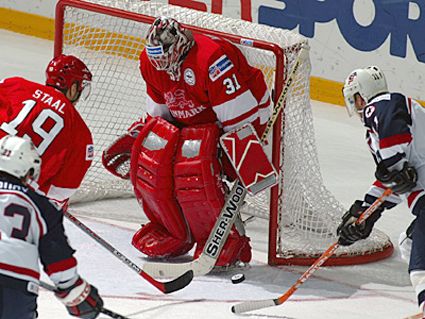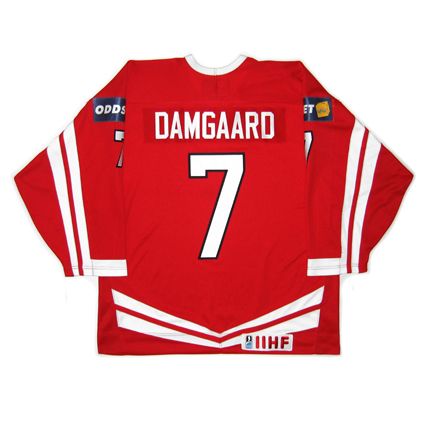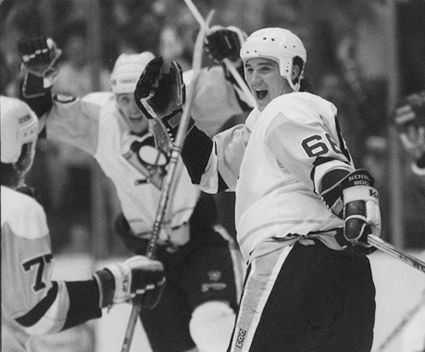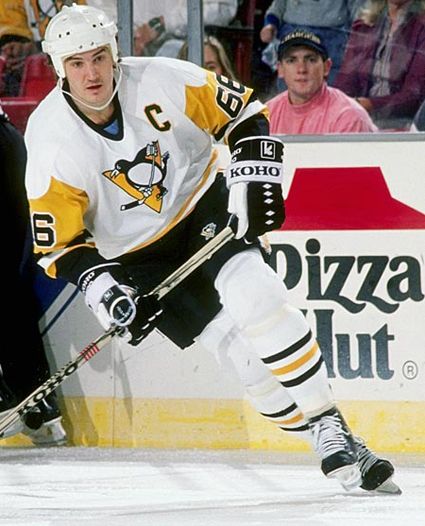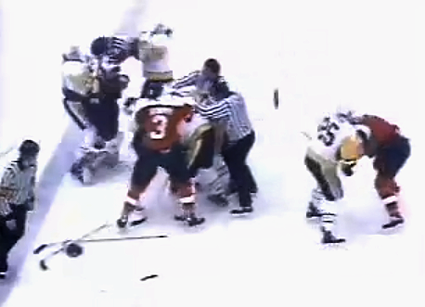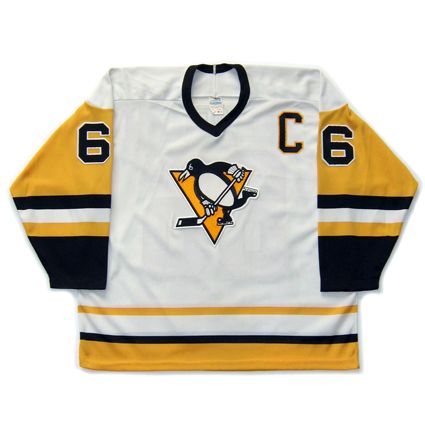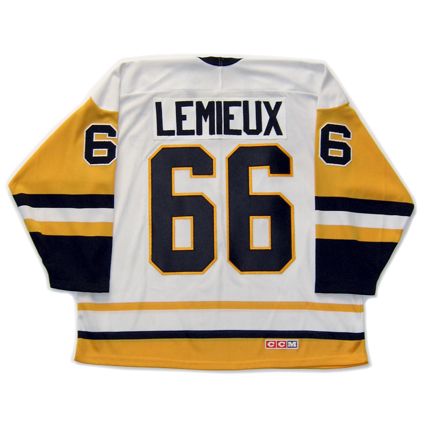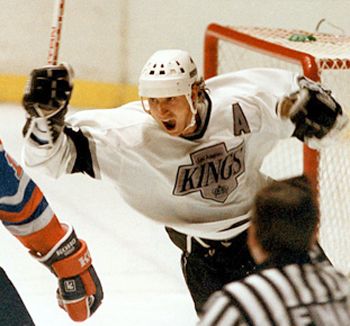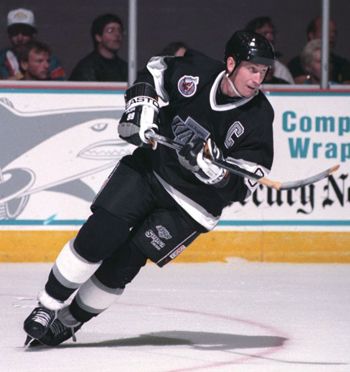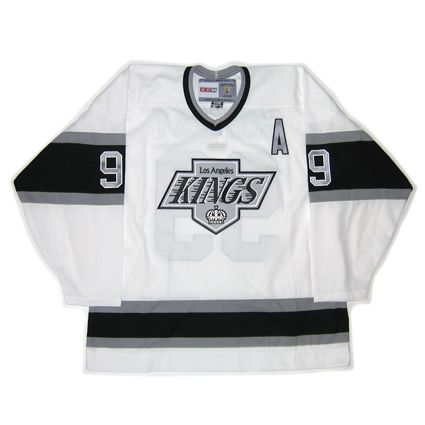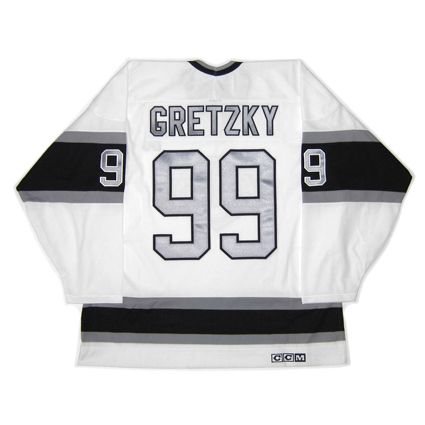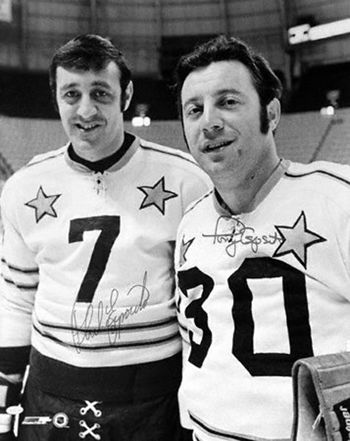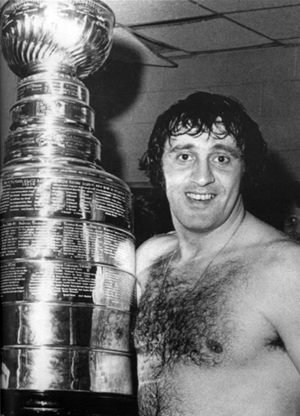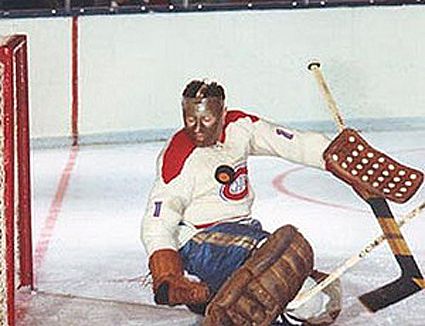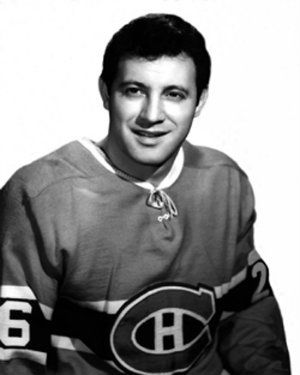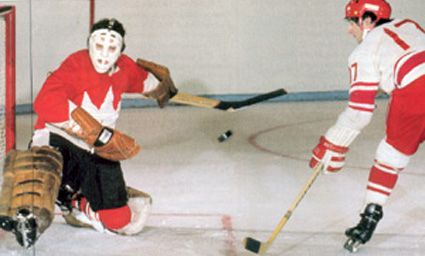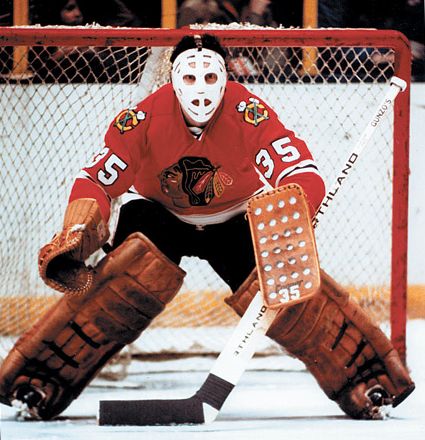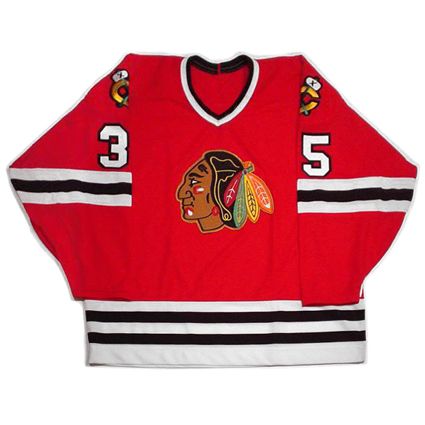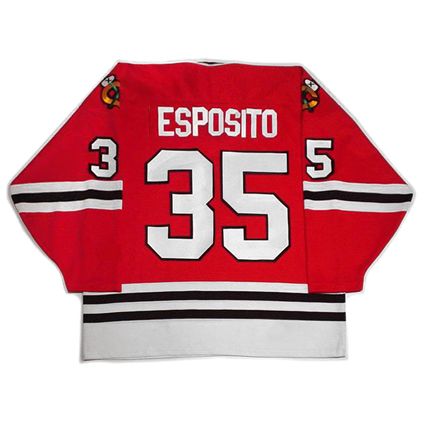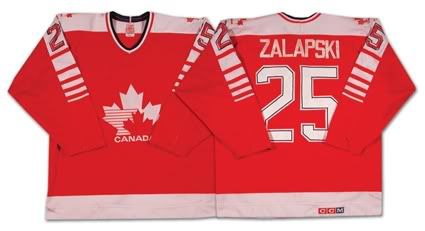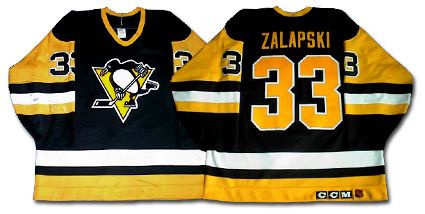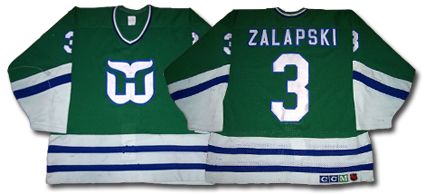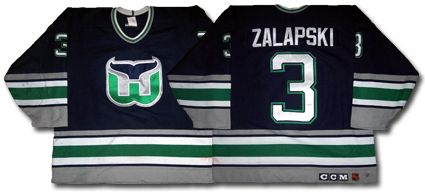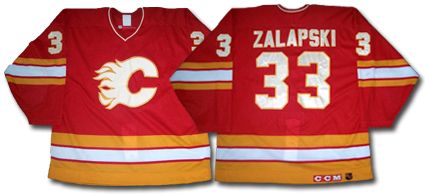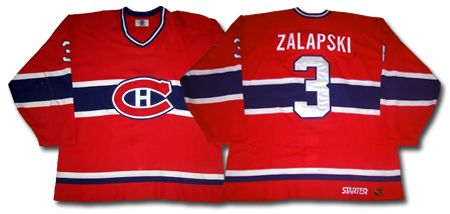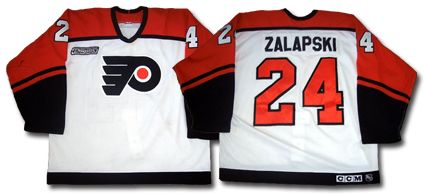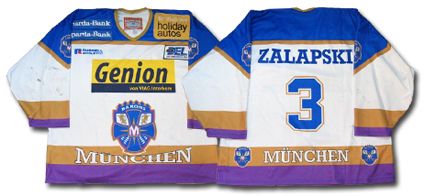Denmark would lose it's next two group games to Russia 6-1 and Switzerland 6-2. Based on their win over the US, the Danes advanced to the next round of group play, where they would tie eventual 2003 World Champions Canada 2-2, as surprising a result as their win over the United States.
Friday, April 26, 2013
2005 Denmark National Team Jesper Damgaard Jersey
On this date in 2003, Denmark pulled off one of the biggest upsets in the history of the World Championships with a shocking 5-2 win over the United States.
Making its return to the Top Division for the first time in 54 years, Denmark immediately scored it's biggest hockey victory ever in the opening game of the tournament, which was held in Tampere, Finland.
Kim Staal, who had seven years of professional experience in the Swedish Elitserien, led the Danes with two goals and two assists.
The Americans, with 12 NHLers on it's roster, outshot Denmark 55-22 but could not solve goaltender Peter Hirsch, who made several outstanding saves.
Bo Nordby-Anderson and Staal both scored on breakaways, putting backhanders past American goaltender Ryan Miller 3:42 apart to give Denmark a 2-0 lead in under 10 minutes of the opening period. Jesper Damgaard increased the Danish lead with a one-timer slapshot from the point at 12:21.
Jim Fahey got the United States on the board with a power-play goal at 16:06 of the first period.
At the start of the second period, Chris Rogles, who played in Germany for the Cologne Sharks replaced Miller in the American goal only to have Ronny Larsen score high on the glove side at 3:09 on yet another breakaway.
Kelly Fairchild cut the deficit to 2 with a goal at 2:24 of the third period to give the United States hope, but Hirsch stood strong in goal as the Danes killed of multiple penalties in the period to hold off the Americans despite the huge shot advantage they held.
At the final buzzer, hundreds of rowdy, flag-waving Danish fans celebrated in the stands, with some even brought to tears.
"We didn't feel the pressure," said Denmark head coach Mikael Lundstrom. "We're not here on vacation. We're not here just to learn, but to play some good games. We know that we have some forwards who can score goals, Kim Staal for instance. We didn't say that we should go out and win, but we said we would do our best ad try to play a good game."
Denmark would lose it's next two group games to Russia 6-1 and Switzerland 6-2. Based on their win over the US, the Danes advanced to the next round of group play, where they would tie eventual 2003 World Champions Canada 2-2, as surprising a result as their win over the United States.
Denmark would lose it's next two group games to Russia 6-1 and Switzerland 6-2. Based on their win over the US, the Danes advanced to the next round of group play, where they would tie eventual 2003 World Champions Canada 2-2, as surprising a result as their win over the United States.
Losses to Sweden (7-1) and Latvia (4-2) would end the fun for Denmark, but they had to consider their tournament a success, having avoided relegation in their long-awaited return to the Top Division.
Denmark currently ranks 12th in the IIHF Mens' World Rankings and has played at the top level of the World Championships since 2003, finishing as high as 8th in 2010. While finding themselves in the Relegation Round three out of their first seven years in the Top Division, the Danes successfully avoided the drop each time and have not been in a position to be relegated since 2009.
Current Danes in the NHL include Jannik Hansen of the Vancouver Canucks, Mikkel Bødker of the Coyotes, Franz Nielsen of the Islanders, Lars Eller of the Montreal Canadiens, Philip Larsen of the Stars and the Senators Peter Regin with several others on the verge in the AHL. Other successful Danes currently play in the Swedish Elitserien.
Today's jersey is a 2005 Denmark National Team Jesper Damgaard jersey. Damgaard, a defenseman, is the long-time captain of the Danish National Team and has played for Denmark at the World Championships 14 times, leading the team in games played with 240. This jersey features a pair of custom printed Oddset sponsor patches.
Labels:
Damgaard Jesper,
Denmark
Thursday, April 25, 2013
1988-89 Pittsburgh Penguins Mario Lemieux Jersey
On this date in 1989, Mario Lemieux tied the all-time NHL record for most points in a playoff game when he scored five goals and three assists as the Penguins outlasted the Philadelphia Flyers 10-7 in a wild, brawl filled shootout in Game 5 of the Patrick Division Finals.
Prior to the playoffs, Lemieux set personal records in goals (85), assists (114) and points on his way to the NHL scoring title, easily outdistancing Wayne Gretzky 199 points to 168, despite missing four games. At the time, his 85 goals were the third most of all-time and he became the third player ever to reach 100 assists in a season. Additionally, he scored 13 shorthanded goals to set a new NHL record. Perhaps the most remarkable achievement of Lemieux's stellar 1988-89 season was joining the exclusive 50 goals in 50 games club, only the fifth player at the time to achieve the feat first accomplished by the famed Rocket Richard when he scored his 50th of the season in his 46th game.
Also during the same season, Lemieux had one of the most remarkable nights in NHL history on New Year's Eve in 1988 when he scored five goals - in five different ways! He started the night with an even strength goal and followed it with one shorthanded, on the power play, a penalty shot and capped off his amazing night with an empty net goal.
On the basis of Lemieux's brilliant season, the Penguins qualified for the playoffs for the first time in seven seasons. The New York Rangers fell to the Penguins in four straight before Pittsburgh advanced to face the Flyers. Game 1 went to the Penguins at home 4-3 and then the Flyers took Game 2 by a score of 4-2. Pittsburgh fought back with a 4-3 overtime win in Philadelphia and the Flyers evened the series 4-1 on home ice to send the series into Game 5 tied at two games apiece.
Game 5, played on this date in 1989, started with a goal by Lemieux at 2:15 into the game. He added his second exactly a minute and a half later for a 2-0 Penguins lead and the tone was set when he completed his hat trick on the power play just 6:55 into the game to put the Penguins up 3-0!
After Bob Errey extended the Penguins lead to 4-0 just 12 seconds after Lemieux's third goal, the Flyers got on the board with a goal to briefly give them a faint glimmer of hope only to have Lemieux then tie an NHL record with his fourth goal of the period at 17:09 on a wraparound into an unguarded net after he stole the puck from Flyers goaltender Ron Hextall, sending the home fans into a frenzy. The Penguins added one more prior to the horn to head into the intermission up by a remarkable score of 6-1.
Lemieux's hat trick in the opening seven minutes was just the beginning
After Bob Errey extended the Penguins lead to 4-0 just 12 seconds after Lemieux's third goal, the Flyers got on the board with a goal to briefly give them a faint glimmer of hope only to have Lemieux then tie an NHL record with his fourth goal of the period at 17:09 on a wraparound into an unguarded net after he stole the puck from Flyers goaltender Ron Hextall, sending the home fans into a frenzy. The Penguins added one more prior to the horn to head into the intermission up by a remarkable score of 6-1.
The second period was more of the same, with the teams combining for five more goals. The Flyers scored twice but the Penguins answered each time to restore their five goal lead. The Flyers frustrations then began to boil over, which included a misconduct penalty to Hextall at 12:55.
The Penguins extended their lead to six with their third goal of the period at 12:55 to give them a 9-3 entering the third period, but not before Brian Dobbin of Philadelphia received a match penalty for attempt to injure John Cullen during their fight at 17:03. Lemieux assisted on all three of Pittsburgh's second period goals to give him seven points on the night - so far.
The Penguins extended their lead to six with their third goal of the period at 12:55 to give them a 9-3 entering the third period, but not before Brian Dobbin of Philadelphia received a match penalty for attempt to injure John Cullen during their fight at 17:03. Lemieux assisted on all three of Pittsburgh's second period goals to give him seven points on the night - so far.
The Flyers let the Penguins know they were not going to quit when they scored 48 seconds into the third period as they then staged a furious rally to close the gap to 9-7 with three more goals between 10:21 and 17:23 before Lemeiux completed his eight point night with his fifth goal of the night, to go with three earlier assists, at 19:23 into an empty net to seal the 10-7 Penguins victory.
The Flyers then began the "message sending" of the era with the game now out of hand with a fight at 19:44 and an all-out line brawl with only nine seconds remaining which included all the players on the ice, including the Flyers goaltender Ken Wregget, who got involved to keep the numbers even, as Philadelphia was shorthanded from the previous altercation.
The Flyers then began the "message sending" of the era with the game now out of hand with a fight at 19:44 and an all-out line brawl with only nine seconds remaining which included all the players on the ice, including the Flyers goaltender Ken Wregget, who got involved to keep the numbers even, as Philadelphia was shorthanded from the previous altercation.
Lemieux tied NHL records for most goals (5) and most points (8) in a playoff game as well as most goals in one period in a playoff game (4 in the first period) and most assists in a period in a playoff game (3 in the second period) that night.
The eight point night was the third of Lemieux's season, as he put up eight in the fourth game of the season and again on New Year's Eve, the aforementioned night he scored goals in five different ways. Lemieux remains the only player in NHL history to have scored eight points in a game three separate times, a feat he accomplished in a single season! It also remained the last time anyone scored eight in a game for 23 years until Sam Gagner managed the feat in 2012.
His eight points in a playoff game is one of only two times in history the feat has been accomplished and his eight points are tied for second for the most points ever scored in an NHL game behind Darryl Sittler's 10.
Today's featured jersey is a 1988-89 Pittsburgh Penguins Mario Lemieux jersey. as worn during Lemieux's record setting eight point night in the playoffs. This was the first season for this particular lettering style on the Penguins jerseys, as previous seasons had a different specification with a thinner number font, serifs on thicker letters for the names and sleeve numbers up on the shoulders, football style.
Today's video section takes a look at the Penguins - Flyers playoff series in 1989, which includes Lemeiux's historic eight point night in Game 5. Ah, Michael, Michael motorcycle!
Here is Rob Brown scoring the Penguins 9th goal, which sets off the always tightly-wound Ron Hextall. Lemieu'x assist o the goal was his 7th point of the game.
Labels:
Lemieux,
Pittsburgh Penguins
Wednesday, April 24, 2013
1988-89 Los Angeles Kings Wayne Gretzky Jersey
On this date in 1989, the Los Angeles Kings Wayne Gretzky scored his 86th career playoff goal, making him the leading goal scorer in playoff history, passing Mike Bossy's 85, in a 5-3 loss to the Calgary Flames.
Gretzky's first NHL season came in 1979-80 following his Edmonton Oilers being absorbed by the NHL. He would score 2 goals in 3 games to begin his assault on the record. The following season saw the Oilers advance to the second round for the first time and gain 9 games of playoff experience in which Gretzky would add 7 goals. A quick exit the following season limited Gretzky to just 5 playoff games in which he would score 5 goals.
The 1983 playoffs would begin a remarkable period in Stanley Cup playoff history, as the Oilers would advance to the finals for the first time, playing 16 games along the way. It was the first of seven consecutive seasons in which the Gretzky would play a minimum of 10 post-season games, and often upwards of 16 with a high of 21 in 1987, giving Gretzky 114 games in seven seasons to add to his playoff goal scoring totals during the height of the Oilers dynasty.
His goal totals would rise from 12 in 1983, to 13 during the Oilers first Stanley Cup championship in 1984 to his best ever with 17 as they repeated as cup champions and Gretzky was named the winner of the Conn Smythe Trophy in 1985. Those 17 goals in 1985 rank as the third highest in a single playoff year. For the remainder of the streak of double-digit playoff game seasons, he scored 8 in 1986, 5 in 1987 on the way to another Stanley Cup, 12 in 1988 for Gretzky's second Conn Smythe Trophy and fourth and final Stanley Cup.
Following that season, Gretzky was famously traded to the Los Angeles Kings, where the playoff run of double-digit games would continue. He would score 5 goals in 11 games to put his career total at 86, with the 5th goal coming on this date in 1989, which moved him into first place all time, surpassing the record of 85 held by Bossy since his retirement in 1987.
Gretzky during his record setting 1989 playoffs,
evidenced by his wearing the assistant captain's "A".
The Kings would make the playoffs for the next four seasons, allowing Gretzky to make the Stanley Cup playoffs for fourteen consecutive seasons. Hampered by injuries, Gretzky would only play in 7 of the Kings 10 playoff games in 1990, which limited him to just 3 goals.
He would score 4 more in 12 games in 1991 and a pair in 1992 as the Kings were bounced after 6 games in the first round.
1993 saw the Kings take a run at the maximum number of possible games, as they had a 6 game series in the first round, 6 in the second, the full 7 in the conference finals and five more in the cup finals, for a total of 24 games out of a maximum 28. Gretzky led Los Angeles with 15 goals that postseason, the second highest of his career, which allowed him to become the first player in NHL history to surpass 100 career playoff goals.
Unfortunately, the Kings would fail to qualify for the playoffs over the next two seasons, and with things looking bleak for the future, Gretzky was traded to the St. Louis Blues late in the 1995-96 season, allowing him another shot at the playoffs for the first time in three seasons. His role was mainly as a playmaker, as he produced assists at a rate of more than one per game, but was limited to only 2 goals in 13 contests.
He moved to the New York Rangers for 1996-97 season and scored the final 10 playoff goals of his career in 15 games as the Rangers made a run to the Eastern Conference Finals. Gretzky's career would wind down over the next two seasons as the Rangers would fail to qualify for the playoffs either season, leaving his career total at an NHL record 122 goals.
Today's featured jersey is a 1988-89 Los Angeles Kings Wayne Gretzky jersey. Gretzky, the long time captain of the Oilers wore the "A" as an assistant captain during his first season in Los Angeles in deference to the Kings incumbent captain Dave Taylor.
1988-89 was the first season for the Kings new uniform set, as they radically changed their entire look, abandoning the purple and gold colors of royalty, which they shared with the NBA's Los Angeles Lakers, to the trendy and very much in favor black with the addition of silver and white, which they would share with the Raiders of the NFL, who also played in Los Angeles from 1982 to 1994.
While the basic jersey worn by the Kings would remain unchanged from 1988 to 1998, the customization would go through a series of detail changes. The white jerseys started life with silver names and numbers outlined in black and the name on nameplates. The sleeve numbers were silver outlined in white.
In 1991, the names and numbers changed to three colors, silver trimmed in white and outlined in black for one season. The names were no longer on nameplates. Finally, in their fifth season of use, the numbers would change to a higher contrast and much more readable black, which were trimmed in white and outlined in silver. The names were simplified to one color black and this specification would remain in effect throughout the rest of the life of the jerseys.
The black jerseys would have a similar history, starting out with silver names and numbers outlined in white and silver sleeve numbers outlined in black and the names on a nameplate.
1991 saw the move to three colors in the combination of silver names and numbers trimmed in black and outlined in white. Sleeve numbers were now silver trimmed in white and outlined in black, while the nameplates were no longer in use.
Changes for 1992 saw the names simplified to one color white, while the sleeve numbers were changed to black, trimmed in white and outlined in black and would remain this way until this set was replaced in 1998-99.
Labels:
Gretzky Wayne,
Los Angeles Kings
Tuesday, April 23, 2013
1981-82 Chicago Black Hawks Tony Esposito Jersey
While not as numerous as the Sutters or Plagers, as flashy as the Bures, identical as the Sedins, offensively gifted as as a pair as the Richards, as highly paid as the Staals or as clandestine as the Stastnys, no other pair of brothers are as accomplished as the Esposito brothers.
Phil, the older by two years was a two time Stanley Cup champion, five time Art Ross Trophy, two time Hart Trophy, two time Lester Pearson Trophy and Lester Patrick Trophy winner. He was a 10 time NHL All-Star, had his #7 retired by the Boston Bruins and was inducted into the Hockey Hall of Fame in 1984. Phil retired as the second leading scorer in NHL history and holder of the single season goal scoring record with 76.
Tony Esposito, born on this date in 1943, was two years younger than Phil, played college hockey for Michigan Tech University where he was a three time All-American and backstopped the Huskies to the 1965 NCAA championship.
He first played in the NHL with the Montreal Canadiens when both Gump Worsely and Rogie Vachon were injured and saw action in 13 games, including giving up a pair of goals to his brother Phil during his very first game!
After being returned to the minors, he was called up during the playoffs when Worsley was again hurt and was part of the Canadiens Stanley Cup winning team.
Tony during his early days trying to crack the Canadiens linuep
After being returned to the minors, he was called up during the playoffs when Worsley was again hurt and was part of the Canadiens Stanley Cup winning team.
The Canadiens, deep in goaltending, left Esposito unprotected in the waiver draft, where he was claimed by the Chicago Black Hawks. He immediately set a modern NHL record with 15 shutouts, still an NHL rookie record, and a career high 38 wins on the way to being named the winner of the Calder Trophy as well as his first Vezina Trophy.
During his second season, he would guide the Black Hawks to the Stanley Cup Finals. The following season of 1971-72 saw Esposito earn his second Vezina Trophy on the basis of nine shutouts and a goals against average (GAA) of 1.77.
Prior to the start of the 1972-73 season, Esposito was named to Team Canada and was the first goalie to defeat the Soviet Union. He finished the Summit Series with a win in Game 2, a tie in Game 3, a loss in Game 5 and a victory in Game 7, as Team Canada, led offensively and emotionally by his brother Phil came back to defeat the Soviets 4-3-1 in the dramatic Game 8.
The Black Hawks, despite the departure of Bobby Hull to the WHA, returned to the Stanley Cup Finals in 1972 as Tony posted a 32-17-7 record, one of eight seasons with 30 wins or more.
1973-74 saw "Tony O" hit double digits in shutouts for the second time in his career with ten on his way to a 2.04 GAA and another Vezina Trophy, one of just eight goalies to win the Vezina catching right-handed.
Over the course of the next seven seasons, Esposito would continue his consistent play, appearing in between 66 and 69 games and winning between 24 and 31 times, as the Black Hawks won several division titles but failed to find playoff success.
In 1981, he became a naturalized American citizen and competed in goal for the United States in the 1981 Canada Cup.
The final three seasons of his career saw his number of games played decline from 52 to 39 to 18 in his final season of 1983-84, but he would record his sixth playoff shutout on this date, his birthday, in 1982 with a 2-0 win over rivals the St. Louis Blues.
Esposito, who originally wore #29 with Montreal, was the first NHL goalie to officially wear the #35, which was assigned to him in training camp due to the traditional goalie numbers 1 and 30 already being assigned. Following a shutout in his first ever exhibition game, he stuck with 35, making it an iconic number for goaltenders for decades to come.
Aside from becoming known for his #35, Esposito is also instantly recognized for his immediately recognizable goalie mask and stance. His mask would later have the addition of protective bars on the front, a precursor to today's hybrid mask worn by nearly all goaltenders at all levels.
Esposito retired in 1985 and was elected to the Hockey Hall of Fame in 1988 and saw his #35 retired by the Black Hawks later that same year.
Today's featured jersey is a 1981-82 Chicago Black Hawks Tony Esposito jersey as worn the year in which he recorded his final NHL playoff shutout. This jersey sports the now iconic #35, pioneered by Esposito and adopted by goaltenders all throughout the 1970's, 80's and 90's such as Tom Barasso, John Sebastian-Giguere, Nikolai Khabibulin (who originally wore #53 when he joined the Blackhawks), Henrik Lundqvist, Andy Moog, Evgeni Nabokov, Mike Richter, Tommy Salo, Tim Thomas and Marty Turco among many others.
Today's video section begins with a tribute to Tony Esposito by the Chicago Black Hawks from "Tony Esposito Night" in Chicago on March 19, 2008 as the Blackhawks honored Tony and welcomed him back into the Black Hawks family.
Here is the ceremony, in two parts, to honor Esposito on "Tony Esposito Night".
Labels:
Chicago Blackhawks,
Esposito Tony
Monday, April 22, 2013
The Top Twenty Names in Hockey History
Here is the Top Twenty Names in Hockey History, as chosen by the staff of Third String Goalie.
Don't agree? Send us your favorites in the comments below!
Don't agree? Send us your favorites in the comments below!
Top Twenty Names in Hockey History20. Lou Franceschetti19. Chico Maki18. Branko Radivojevic17. Lucien DeBlois (DEB Low Wah)16. Maxim Afinogenov15. Ilkka Sinisalo14. Tony Twist13. Pekka Rinne12. Frank St. Marseille11. Peter Sidorkiewicz10. Kari Takko9. Bubba Berenzweig8. Sheldon Kannegiesser7. Radek Bonk6. Ron Tugnutt5. Parris Duffus4. Valeri Zelepukin3. Per Djoos (pron: Pear Juice)2. Hakan Loob
And, without a doubt, the greatest name in hockey history, Zarley Zalapski, was born on this date in 1968.
Following two seasons of junior hockey Zalapski played three seasons for the Canadian National Team, then a season long proposition which many players used as a stepping stone to the NHL.
He was drafted fourth overall by the Pittsburgh Penguins in the 1986 NHL Entry Draft and made his NHL debut following the 1988 Olympics in Calgary, Alberta. He would play four seasons for the Penguins, playing a high of 66 games before being traded near the end of the 1990-91 season and just missing out on the Penguins run to the Stanley Cup.
1987-88 Pittsburgh Penguins
1988-89 Pittsburgh Penguins
Notice the changes in the customization in the Penguins jerseys from Zalapski's rookie year to his sophomore season. The name on the back is thinner and without serifs, the number changes font and the sleeve numbers move from the shoulders down to the arms.
The Penguins dealt Zalapski to the Hartford Whalers as part of the Ron Francis trade, a move that saw Zalapski see an increase in playing time and career highs in points as a result. The defenseman's only 20 goal season of his career came in 1991-92 followed by a 65 point campaign the following season while wearing the Whalers green jerseys.
1990-91 Hartford Whalers
Prior to Zalapski's final season in Hartford, they would change to their new modernized jerseys, which featured blue road jerseys rather than the traditional green.
1993-94 Hartford Whalers jersey
Traded once more, Zalapski was on the move, this time north of the border to Calgary to join the Flames. Once in Calgary, he would find his customary #3 already in use by Frantisek Musil and adopt the #33 while skating for the Flames. He would play in five seasons with the Flames, although he would miss all but two games of the 1996-97 season with a knee injury suffered in practice.
1993-94 Calgary Flames
Zalapski played a more defensive role in Calgary, as he would never again approach the offensive numbers he achieved while in Pittsburgh and especially Hartford. Zalapski also was present for yet another uniform change, as the Flames finally moved away from their traditional jerseys, which remained unchanged, save for the crest, even after their relocation from Atlanta.
The bold new sweaters featured the addition of a shot of black, reminiscent of the change the Minnesota North Stars made in 1981, where the restrained use of black added to the jersey, rather than taking over, such as what the North Stars succumed to in 1991. The main feature of the new design was the arresting diagonal multi-stripe on the front of the jerseys, which originated just below the main crest and shot off in the direction of the right hip. These bold jerseys would remain in use for three seasons before becoming dated.
1994-95 Calgary Flames
After five seasons in Calgary, Zalapski was dealt to the Montreal Canadiens in a deal which brought Valeri Bure to Calgary. His stay in Montreal was brief, playing there for only the second half of the 1997-98 season. Now back in his customary #3 Zalapski would have the honor of wearing the classic "bleu, blanc et rouge" sweater of the storied Canadiens.
1997-98 Montreal Canadiens
The 1998-99 season would see Zalapski's first foray into European hockey with an abbreviated season of just 11 games with the ZSC Lions in Zurich, Switzerland. He returned to North America for the 1999-00 season, which included time with the Long Beach Ice Dogs of the IHL for seven games before spending the majority of the season with the Utah Grizzlies, also of the IHL and a return to the NHL with the Philadelphia Flyers for 12 games.
1999-00 Philadelphia Flyers
His time in Philadelphia would be the conclusion of Zalapski's NHL career, which would finish with 637 games played with five teams, 99 goals and 285 assists for 384 points and one All-Star Game appearance in 1993.
He would begin the 2000-01 season with the Houston Aeros of the IHL for nine games before returning to Europe, this time with the Munich Barons of the German DEL.
2000-01 Munich Barons
A new season meant another new country, as the former NHL All-Star found himself with HC Merano of the Italian league for 26 games. Zalapski began to apparently "dabble" in hockey at this point, playing seven games with IF Bjorkloeven Umea in the Swedish second division in 2002-03, no hockey at all in 2003-04 and 11 games with the Kalamazoo Wings in the UHL in 2004-05.
The 2005-06 season saw a total of just 16 split between three clubs, EHC Visp in the Swiss second division, Innsbrucker EV in Austria and SC Rapperswill-Jona Lakers in the Swiss top division. He suited up for just five games in all of 2006-07 with EHC Chur in the Swiss second division leaving behind a trail of lightly used game worn jerseys in his wake!
2007-08 saw a more serious effort with 33 games for EHC Biel-Bienne, still in the Swiss second division and a move to EHC Olten for a 34 game season and one of the more unique team logos in the world of hockey.
Zalapski continues to play 22 years after his NHL debut, proving once more that there is life beyond the NHL, having moved to Lausanne HC in the Swiss second division and are currently involved in a playoff to determine promotion to the Swiss National League A, the top division of Swiss hockey for 2010-11. Lausanne currently leads Bienne three games to two in their best of seven series with Game 6 scheduled for today and Game 7 if needed on Saturday.
Today's video section begins with Zalapski scoring his first NHL goal on March 19, 1988 on a beautiful feed from Mario Lemieux.
Subscribe to:
Comments (Atom)

